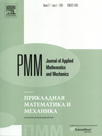 | | Journal of Applied
Mathematics and Mechanics
Russian Academy of Sciences | | Founded
in January 1936
(Translated from 1958)
Issued 6 times a year
ISSN 0021-8928
(print version) |
Archive of Issues
| Total articles in the database: | | 10610 |
| In Russian (ΟΜΜ): | | 9811
|
| In English (J. Appl. Math. Mech.): | | 799 |
|
| << Previous article | Volume 75, Issue 4 / 2011 | Next article >> |
| D.V. Berezhnoi and V.N. Paimushin, "Two formulations of elastoplastic problems and the theoretical determination of the location of neck formation in samples under tension," J. Appl. Math. Mech. 75 (4), 447-462 (2011) |
| Year |
2011 |
Volume |
75 |
Issue |
4 |
Pages |
447-462 |
| Title |
Two formulations of elastoplastic problems and the theoretical determination of the location of neck formation in samples under tension |
| Author(s) |
D.V. Berezhnoi (Kazan, Russia)
V.N. Paimushin (Kazan, Russia, dsm@dsm.kstu-kai.ru) |
| Abstract |
Two formulations of elastoplastic problems in the mechanics of deformable solids with finite displacements and deformations are investigated. The first of these is formulated starting from the classical geometrically non-linear equations of the theory of elasticity and plasticity, in which the components of the Cauchy-Green strain tensor, associated with the components of the conditional stress tensor by physically non-linear relations according to flow theory in the simplest version of their representation, are taken as a measure of the deformations. The second formulation is based on the introduction of the true tensile and shear strains which, according to Novoshilov, are associated with the components of the true stresses by physical relations of the above-mentioned form. It is shown that, in the second version of the formulation of the problem, the use of the corresponding equations, complied taking account of the elastoplastic properties of the material with correct modelling of the ends of cylindrical samples and the method of loading (stretching) them, enables the location of the formation of a neck to be determined theoretically and enables the initial stage of its formation to be described without making any assumptions regarding the existence of initial irregularities in the geometry of the samples. |
| Received |
24 January 2009 |
| Link to Fulltext |
|
| << Previous article | Volume 75, Issue 4 / 2011 | Next article >> |
|
 If you find a misprint on a webpage, please help us correct it promptly - just highlight and press Ctrl+Enter If you find a misprint on a webpage, please help us correct it promptly - just highlight and press Ctrl+Enter
|
|

 Russian
Russian  English
English